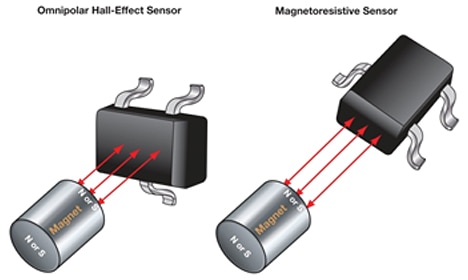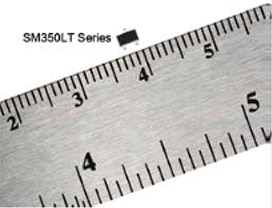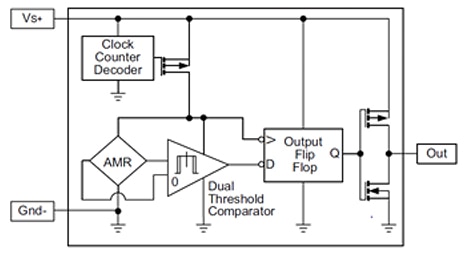Switch Your Switch
2016-02-09
Advances in technology have allowed for magnetic sensors to be smaller, lower power and more sensitive than ever before. Due to these advances, magnetoresistive (MR) sensors, which have always offered significant benefits over Hall-effect and reed switches, should be looked at when designing new systems in need of a position switch.
MR sensors are solid-state switches and have no mechanical parts to operate the switch. They are omnipolar in nature and will actuate when the magnetic field of either the north or south pole of a magnet is in the sensing range. The sensing direction for an MR device is in the parallel plane of the IC which differs from Hall sensors that sense a magnetic field perpendicular to the IC (Figure 1). The switch turns off when the magnetic field is removed from the sensor. In addition, MR sensors are much more sensitive to magnetic fields than Hall-effect and can offer more flexibility and require lower cost magnets for use in applications.

Figure 1: A Hall sensor responds to magnetic fields placed perpendicular to its body while an MR device responds to magnetic fields applied in a direction parallel to the sensor.
Advances in circuit design now allow for magnetic sensors to utilize much lower power than ever before. Most magnetic sensor manufacturers offer sensors that only use microamp supply current to power the sensor. As this technology continues to develop, more design engineers are turning to low-power sensors to replace mechanical switches in battery-powered applications.
Honeywell recently introduced their new Magnetoresistive Sensor ICs, Nanopower Series that includes two sensors, SM351LT and SM353LT, which draw only 360 nA and 310 nA, respectively, at 1.8 VDC. These sensors are housed in a tiny SOT-23 package (Figure 2), have an operating temperature of -40˚C to 85˚C, and are a great switch for most battery-powered applications.

Figure 2: Honeywell’s Magnetoresistive Sensor ICs, Nanopower Series are available in a SOT-23 package.
Honeywell nanopower MR sensor IC advantages over hall-effect
When compared to existing Hall sensors, Honeywell’s new MR Sensor ICs, Nanopower Series offer some unique characteristics which translate into several practical advantages, including lower power consumption, reduced system cost, more design flexibility, simplified installation, and less variation around system design.
At 310 nA and 360 nA typical, these new sensors use 1/16th the power of even the most efficient Hall-effect devices available today. For many battery-operated devices, where power budgets are stringent and every nanoamp is counted, this can allow design engineers to either save on battery life, or utilize additional low-power technologies for the same power budget in their application.
To meet these stringent demands, many applications today utilize a design which power cycles the magnetic sensor by utilizing an external clock and circuitry to turn the system on and off in order to bring average current through the system down to less than 500 nA. The new MR Sensor ICs, Nanopower Series by Honeywell, utilize a clock to internally cycle the power (Figure 3) and can therefore simplify application design.

Figure 3: Block electrical diagram of Honeywell’s SM351LT MR Sensor which utilizes a clock to internally cycle power.
Manufacturers can also fine-tune their designs to more closely meet a particular application’s requirements by making small trade-offs between two or more of the sensor’s characteristics. These trade-offs can often produce significant gains in critical capability with a relatively small sacrifice to another parameter. One of the most common trade-offs involves balancing sensitivity against power consumption. For example, Honeywell’s SM351LT is designed for applications requiring ultra-high magnetic sensitivity (7 Gauss (G) typical operate, 11 G maximum operate) and a very low current draw (360 nA typical). For applications requiring slightly lower magnetic sensitivity to activate (14 G typical, 20 G maximum), the SM353LT offers reduced current draw (310 nA typical).
In addition to providing energy savings, the sensor’s CMOS output circuit eliminates the need for external pull-up resistors. MR sensors also eliminate the discrete components needed to filter the electrical noise produced by the chopper circuits, commonly used by Hall-effect devices. Eliminating these discrete components reduces the physical footprint of the sensor assembly, making them much easier to use in space-constrained applications. Manufacturers will also appreciate how the reduced component count can yield a simpler assembly process, improved reliability, and lower overall solution cost.
As an MR device, these new sensors also offer much higher sensitivity than that of Hall-effect devices. In fact, at 7 G and 14 G typical, these sensors can sense the same magnet target at up to two times the distance or more when compared to Hall sensors in the market today. This directly translates to system cost by allowing designers to utilize smaller magnets, or even magnets made of different materials in their system. This is even more important today when rare earth magnet prices are rising at extremely high rates due to a shortage of worldwide supply.
The high sensitivity offered by these MR devices can also allow for more flexibility in design. Using a higher sensitivity MR sensor will allow for larger air gaps between the magnetic target and the sensor. This is useful in many applications where board space is limited, or where the ideal position of the sensor needs to be more than just a few millimeters away from the target.
The omnipolar nature of an MR device may also allow for more simplified installation and fewer manufacturing steps which can result in application quality issues. Unlike unipolar Hall sensors, MR sensors actuate with either pole of a magnet, meaning that the steps prior to installation of the sensor to identify the proper pole of the magnetic target are unnecessary. This in turn, should result in fewer issues due to misplacement of the magnet in the application, and fewer steps in the manufacturing process.
Variations in system design are always a concern for design engineers, and minimizing this is always of utmost importance. When designing a system with magnetic sensors, designers must take into account the variation from the strength of the magnets, placement of the sensor and magnet in the manufacturing process, and the variance of sensitivity from the sensor itself. Minimizing each of these allows for tighter specifications and less overall risk for the application. The new Magnetoresistive Sensor ICs, Nanopower Series from Honeywell help with this by having a smaller variation in sensitivity when compared to other high sensitivity Hall-effect sensors which are at best ±15 G. The SM351LT is 7 G typical (± 4 G min/max), and the SM353LT is 14 G typical (-8 G min, +6 G max).
Honeywell magnetoresistive sensor ICs, nanopower series advantages over reed switches
Honeywell’s SM351LT MR Sensor IC, Nanopower Series should also be considered in battery-powered applications where only reed switches have been commonly used due to low power or high sensitivity needs. When deciding between these two technologies, it is important to note how the unique characteristics of the MR Sensor IC, Nanopower Series can solve many of the issues related to reed switch technology, including breakage, reliability, durability and size while maintaining a competitive price for a tradeoff of utilizing very little power.
Reed switches are composed of a pair of magnetizable, flexible, metal reeds, typically packaged in a glass capsule. The relay acts as a normally-open switch which can be closed by a magnetic field and therefore utilizes no power to operate. In addition, high sensitivity reed switches can reach up to 10 amp turns (AT) which is equivalent to approximately 10 G when both poles of the magnet are directly over the switch. This high sensitivity, coupled with no power to drive the switch, allows it to work very well in battery applications with high sensitivity needs such as water meters and security systems.
On the flip side, breakage from bending the leads during installation, or due to heavy shock and vibration, are common issues with these magnetic switches. 10 AT reed switches can also be relatively large for their applications, and as a mechanical switch, they wear out over time.
The SM351LT MR Sensor IC, Nanopower Series was designed to give design engineers an alternative to reed switches in battery-powered applications. The 7 G typical, 11 G max sensitivity, allows it to sense a magnetic target at the same distance or better than even the best reed switches. In addition, the 360 nA typical supply needed to power the sensor was designed to work with even the most power sensitive battery-powered applications, including water and gas metering.
In addition to its high sensitivity and nanopower capabilities, the SM351LT MR Sensor IC, Nanopower Series by Honeywell is a solid-state switch. This means that there are no mechanical parts and that the sensor should never wear out. The industry standard SOT-23 plastic molding package is also smaller and more durable than the glass packaging found in reed switches. This creates the ability to build smaller products, allows for less breakage during installation and can be counted on to work properly in shock and vibration applications.
Examples of potential nanopower MR sensor applications
Some of the applications where MR sensors’ advantages are allowing them to quickly displace reed switches and Hall-effect devices include:
Gas, water and electric meters (anti-tamper switch): The sensor detects the presence of a magnetic field applied to the utility meter with a large external magnet in an attempt to slow down or stop the meter counting function. High sensitivity enables extended range while low operating power enables long battery life.
Gas and water meters (counting): Used as a counting device for flow detection. Nanopower allows for long battery life which is usually expected to be seven to ten years or more.
Door and window position for security sensors: Detects if the door or window is open or closed and sends a signal to a wireless module that transmits the signal to the central control unit for processing.
Commercial building smoke detectors: In this case, the sensor is utilized as the test switch to ensure that the backup battery in commercial building smoke detectors is in working condition. High sensitivity is needed to ensure a good sensing area for the staff to test the system without having a false failure.
Consumer and white goods: Used to sense door/lid closure in refrigerators, microwaves, washers, dryers, self-cleaning ovens and other appliances which need a position sensor for lid/door closure detection. The MR sensor’s compact footprint and high sensitivity provides more flexibility in location and mounting, enabling more creative, cost-effective designs.
Medical systems: The MR sensor’s high sensitivity and ultra-low power is suitable for battery-operated medical equipment, such as cartridge detection for infusion pumps. The small footprint helps designers achieve the compact form factors required in modern medical equipment.
Handheld and mobile devices: The MR sensor’s ultra-low power characteristics and small size makes it suitable for battery-operated consumer electronics applications, which use lid detection to sleep the product for power savings.
Summary/Conclusions
Whether it’s improving an existing design, or using their unique capabilities to create new types of products that weren’t previously possible, MR sensors free designers from the limitations associated with earlier mechanical reed switches and Hall-effect devices. They provide cost-effective solutions for industrial, medical and consumer applications which are already changing the way many products are designed and manufactured.
The compact footprint and high sensitivity of an MR sensor opens up new degrees of freedom for designers who must integrate these sensors into the products they create. Designers can take advantage of the MR sensor’s high sensitivity to utilize smaller, less expensive magnets or add design flexibility by working with a larger air gap. Thanks to the solid-state design, small footprint and durable plastic molded packaging, designers can take advantage of a broader range of options for where MR sensors can be located, while improving the durability and manufacturability of the products which incorporate them.
Honeywell’s new Magnetoresistive Sensor ICs, Nanopower Series are a game-changer for remote sensing devices and other battery-powered applications where it can dramatically improve the operating life. With average current draw measured below 500 nA, these sensors will enable designers to create new classes of battery-powered products that were not practical with other position sensing technologies.
免责声明:各个作者和/或论坛参与者在本网站发表的观点、看法和意见不代表 DigiKey 的观点、看法和意见,也不代表 DigiKey 官方政策。








